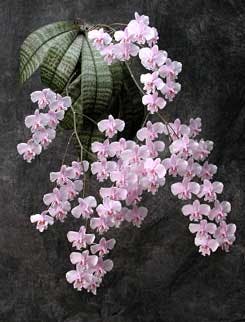
Phalaenopsis schilleriana 'Karen Rockwell' HCC/AOS
Hybrid Phalaenopsis have reached a popularity unimagined thirty, even twenty years ago. They have done what no other orchid was able to do by becoming a favorite houseplant. They have introduced thousands of people to this wonderful family of plants. As varied and attractive as these hybrids can be, there is a certain charm that their species ancestors possess that makes them worthwhile additions to any orchid collection. Although there are other choice candidates, Phalaenopsis schilleriana may arguably be the most popular species in the genus. This pink-flowered Phalaenopsis truly lives up to the genus' moniker, "Moth Orchids". As an added bonus, the beautiful barred leaves make for an attractive houseplant even when not in flower. And most flowers have a delicate rose fragrance when in bloom.
Phalaenopsis schilleriana was described by H.G. Reichenbach in 1860 and named after Consul Schiller who first flowered the orchid two years earlier. The species is endemic to the Philippines where it enjoys the warm tropical climate. Phal. schilleriana has been popular among hobbyists since its discovery is generally easy to find for purchase. The AOS has granted some thirty awards to the species including a number of awards for culture. Christenson cites one valid variation in his monograph, Phalaenopsis (2001); Phalaenopsis schilleriana f. immaculata (Rchb.f.) Christenson. This form lacks the characteristic spotting of the base of the lip and callus.

Phalaenopsis schilleriana 'Pink Elephant' AM/AOS
For a species orchid, Phal. schilleriana is among the easiest to grow and is nearly as tolerant of a wide range of conditions as hybrids. Phalaenopsis' low light requirements make this a suitable species for windowsill and under-lights growers. Choices for potting media are varied and are usually selected by climate and growing conditions. Northern growers prefer a moisture-retaining mix such as peat based "mud mixes" or medium fir bark. Southern growers tend toward coarser potting media like medium fir bark or coconut husk chunks often ammended with additives: Diatomite, sponge rock or chunky peat. We use sphagnum moss in clay pots for all of our Phals here in South Florida and will often add some lava rock or charcoal chunks to open it up a bit. Most growers use plastic pots because it retains moisture better but here in hot Florida we find the moisture evaporative qualities of clay may help keep roots a little cooler. If you have the luxury of space, Phaahaenopis grow nicely in hanging pots that allow the leaves to droop naturally. This also helps avoid crown rot and if you do not stake the inflorescence, it will arch naturally and make a beautiful graceful presentation.
Phalaenopsis light conditions conditions should generally be quite shady with no direct sunlight but we find that the heavily barred foliage of Phalaenopsis schilleriana and its close relative, Phal. stuartiana, seem to tolerate a little brighter conditions, especially if there is a fan nearby. Our Phals have tolerated temperatures into the 40's F but to keep plants in prime condition do not subject them to lower than 60 ° F. Cooler night temperatures in the fall, 55 ° F., are needed to initiate flower spikes. Fertilizer regimen should be the same as for your other orchids; weakly weekly and cut back to twice a month in winter.
Most Phalaenopsis are not plagued by too many pests but spider mites and soft brown scale are the most common. Household remedies such as rubbing alcohol and a soft toothbrush work well if the problem is addressed early on. See the pest and disease section of www.aos.org regarding specific remedies for individual pests.

Phalaenopsis schilleriana creates a striking presentation when the flowers are allowed to develop to a naturally arched pendant inflorescence.
References
Cootes, Jim. 2001. The Orchids of the Philippines. Timber Press.
Christenson, Eric A. 2001. Phalaenopsis, a Monograph. Timber Press.
Greg Allikas, March 2009








